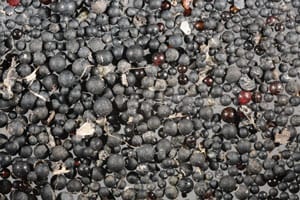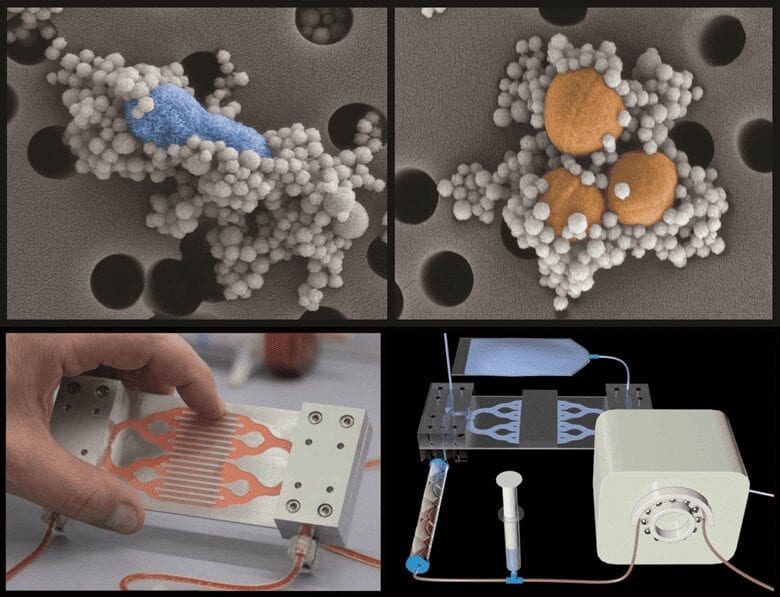
Previously undocumented in North American rivers, concentrations of microplastic particles in the St. Lawrence are as high as has been observed in the world’s most contaminated marine sediments.
A team of researchers from McGill University and the Quebec government have discovered microplastics (in the form of polyethylene ‘microbeads’, <2 mm diameter) widely distributed across the bottom of the St. Lawrence River, the first time such pollutants have been found in freshwater sediments. Their research was published this month in the Canadian Journal of Fisheries and Aquatic Sciences.
The microbeads likely originate from cosmetics, household cleansers, or industrial cleansers, to which they are commonly added as abrasives. Owing to their small size and buoyancy, they may readily pass through sewage treatment plants. Microplastics are a global contaminant in the world’s oceans, but have only recently been detected in the surface waters of lakes and rivers.
Researchers lowered a steel grab from a boat to collect sediment from ten locations along a 320 km section of the river from Lake St. Francis to Québec City. Microbeads were sieved from the sediment, and then sorted and counted under a microscope. “We found them in nearly every grab sample taken. The perfect multi-coloured spheres stood out from natural sediment, even though they were the size of sand grains,” said the lead author of the study, Rowshyra Castañeda, a former McGill MSc student (now at University of Toronto).
At some locations, the researchers measured over 1000 microbeads per liter of sediment, a magnitude that rivals the world’s most contaminated ocean sediments. “We were surprised to find such concentrations at the bottom of a river”, says McGill professor Anthony Ricciardi, who supervised the study. “It was previously assumed that floating microplastics are flushed through rivers to the sea. Now we have evidence that rivers can act as a sink for this pollution.”
The prevalence of microplastics in the St. Lawrence River raises the possibility that they are being consumed by fish and other animals. The environmental effects of microplastics are poorly known; but the surfaces of such particles attract chemical pollutants, including PCBs, which can be transferred to animals that ingest the plastics. “At present, we cannot predict the consequences of the accumulation of these non-biodegradable particles in freshwater ecosystems” added Ricciardi, whose lab is investigating whether the microbeads are being consumed by fish in the river.
The Latest on: Microplastic pollution
[google_news title=”” keyword=”Microplastic pollution” num_posts=”10″ blurb_length=”0″ show_thumb=”left”]
via Google News
The Latest on: Microplastic pollution
- The Environment Agency Abu Dhabi Assesses Microplastic Levels In Abu Dhabi's Marine Environmenton April 30, 2024 at 6:50 am
The Environment Agency – Abu Dhabi (EAD) and the Abu Dhabi Quality and Conformity Council (QCC) announced a landmark partnership to address the growing global challenge of microplastic pollution in ...
- Environment Agency – Abu Dhabi assesses microplastic levels in Abu Dhabi’s marine environmenton April 30, 2024 at 3:47 am
Abu Dhabi (EAD) and the Abu Dhabi Quality and Conformity Council (QCC) announced a landmark partnership to address the growing global challenge of microplastic pollution in the Abu Dhabi marine ...
- Hydrogel to tackle microplastic pollutionon April 29, 2024 at 3:39 pm
Researchers from Indian Institute of Science (IISc) have designed a sustainable hydrogel to remove tiny plastic particles from water using UV light irradiation. The hydrogel consists of intertwined ...
- Researchers develop microplastic-free transparent maskon April 29, 2024 at 1:49 pm
The Korea Institute of Industrial Technology (KITECH) has introduced a new solution in the form of a transparent mask, addressing concerns surrounding microplastic pollution and harmful solvents of ...
- Toxic microplastic hotspots found in Long Island Sound by CT nonprofit advocacy groupon April 28, 2024 at 2:00 am
The nonprofit Rozalia Project for a Clean Ocean found that most of the plastics in Long Island Sound probably started out as polyester fabrics.
- Breakthrough in microplastic detection: Dr SaeJune Park pioneering sensors with future telecommunication technologyon April 26, 2024 at 4:34 am
Dr Park's project represents a significant advancement in microplastic detection technology. This research, supported by a £450k grant from the Engineering and Physical Sciences Research Council ...
- Student project brings awareness to microfiber pollutionon April 25, 2024 at 6:34 pm
The Microfiber Initiative began in February and seeks to raise awareness of the microplastics released into the environment from textiles as a result of washing clothes.
- Earth Day 2024: What Do We Know About Microplastic Pollution?on April 21, 2024 at 5:00 pm
Improved models, like this new Cornell model, will help scientists to better determine the sources of airborne microplastic pollution, the researchers say. “We can now more accurately attribute the ...
- First Study Reveals High Levels of Microplastic Pollution Along Brazilian Coaston April 20, 2024 at 5:42 am
The Brazilian coast has received visitors with a different objective. Since April 2023, researcher from the Federal Institute of Goiás Guilherme Malafaia and a team of researchers have been traveling ...
- Forensic Science Techniques Used to ID Microplastic ‘Hotspots’ in Open Waterson April 17, 2024 at 1:12 pm
Collaborative study identifies pollution concentrations, calls for targeted action in combating plastic contamination ...
via Bing News










